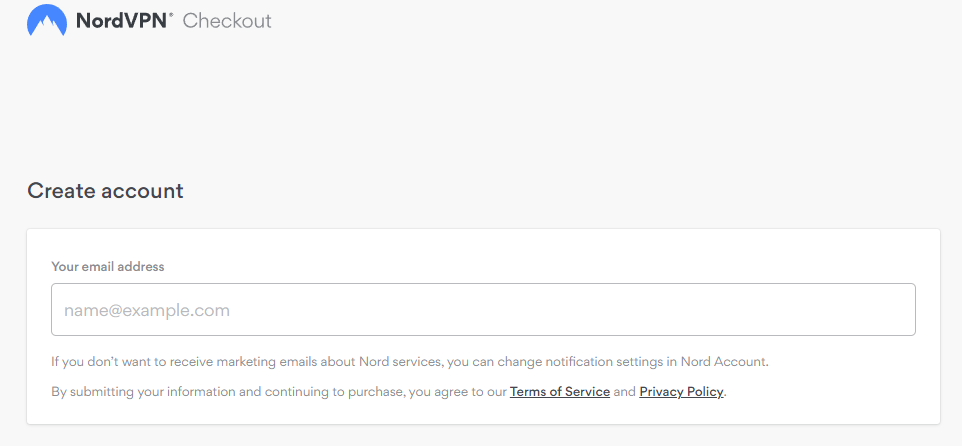Did you decide to purchase NordVPN? Do you wonder: Why Does NordVPN Disconnect My Internet?
In this article we will show you step by step how to make a purchase of new NordVPN subscription, set up account and start using NordVPN software! After guide we will answer some questions regarding using an VPN app.
Table of Contents
Here is how to purchase a NordVPN subscription
- Start by visiting NordVPN website, you can click here.
- Click on pricing tab at the top of the page, here you can see current plans, pricing and deals. Choose which NordVPN plan you prefer to purchase and then click “Get *name of the plan* button.
Click here to get -65% NordVPN Deal!
You can choose between standard plan (pure NordVPN service) or other plans that comes with NordPass or NordLocker services.
- Now you have to type your email adress that you will be using NordVPN with.

- Now you have to choose payment method which you want to use, and proceed with it.
- Well done! If you followed this guide nicely you purchased NordVPN subscription! Look at your email inbox, here you will find purchase confirmation email.
Now download NordVPN APP and start using it
After purchasing your VPN plan, head to this page to download the NordVPN app
Now you can click start and enjoy using VPN!
Click here to get -65% NordVPN Deal!
Let’s get back to answering your questions:
Worth knowing
Another reason why your phone might disconnect from your VPN is if you move out of range of the VPN server. This can happen if you’re using a public Wi-Fi hotspot or if you’re travelling outside of the country and trying to connect to a VPN server in another country. If this happens, you’ll need to reconnect to the VPN when you’re back within range of the server.
If you find that your phone regularly disconnects from your VPN, there are a few things you can do to try and fix it. First, make sure that power saving mode is turned off on your device. This can often interfere withVPN connections. You can also try reducing the strength of the encryption used by your VPN or switching to a different protocol such as OpenVPN or L2TP/IPSec. If all else fails, contact your VPN provider for help troubleshooting the issue.
Worth knowing
1. Your VPN is configured to block all internet traffic when it’s connected. This is usually referred to as a “kill switch” and it’s designed to prevent your data from leaking if your VPN connection drops. To fix this, simply disable the kill switch in your VPN client settings.
2. Your ISP is blocking access to the VPN server’s IP address. This is a common tactic that ISPs use to prevent customers from using VPNs. If this is the case, you’ll need to use a different VPN server or contact your ISP and ask them to unblock the IP address.
3. There’s an issue with your DNS configuration. When you connect to a VPN, your DNS settings should automatically update to route all requests through the VPN tunnel. If this isn’t happening, it could be because your ISP is intercepting and redirecting DNS requests (a technique known as DNS hijacking). You can fix this by changing your DNS settings to use public DNS servers like Google Public DNS or Cloudflare DNS.
4. You’re behind a firewall that’s blockingVPN traffic . If you’re on a corporate network or using public Wi-Fi, it’s possible that outgoing VPN traffic is being blocked by a firewall rule. To fix this, you’ll need to contact whoever manages the network and ask them to open up port 1194 ( UDP ) or 443 (TCP).
Worth knowing
There are a few reasons your VPN might be bogging down your internet speeds. One possibility is that your VPN connection is not set up properly. This can happen if you’re using an outdated or incompatible VPN protocol (like PPTP) or if your connection isn’t encrypted properly.
Another reason for slow speeds could be that your ISP is throttling your bandwidth because they detect that you’re using a VPN. This practice is becoming more common, especially in countries where the government censors the internet (like China and Russia). If this is the case, you might want to consider using a different ISP or a differentVPN server location.
Finally, it’s possible that theVPN server you’re connected to is simply over-loaded or far away from your current location. This can often result in slow speeds since data has to travel further between you and the server. If this is the case, try connecting to a different server or contact your VPN provider for help troubleshooting the issue.
![How to Buy NordVPN in Timor-Leste [NordVPN Purchase Guide]](wp-content/themes/blogstream/img/thumb-medium.png)